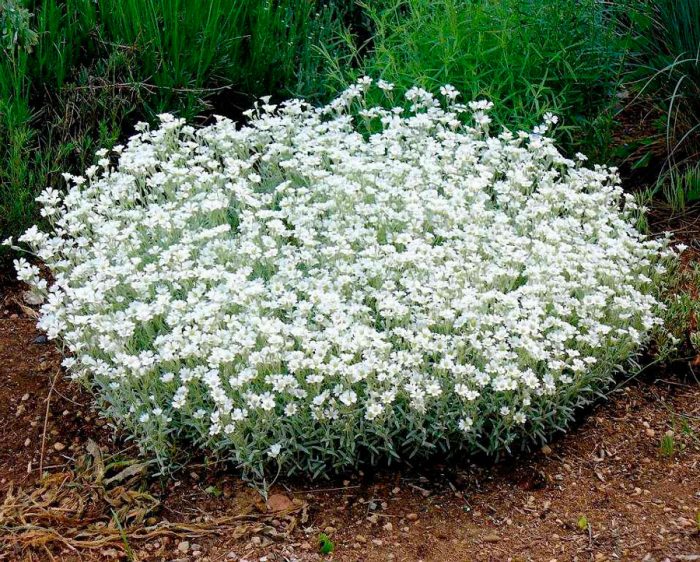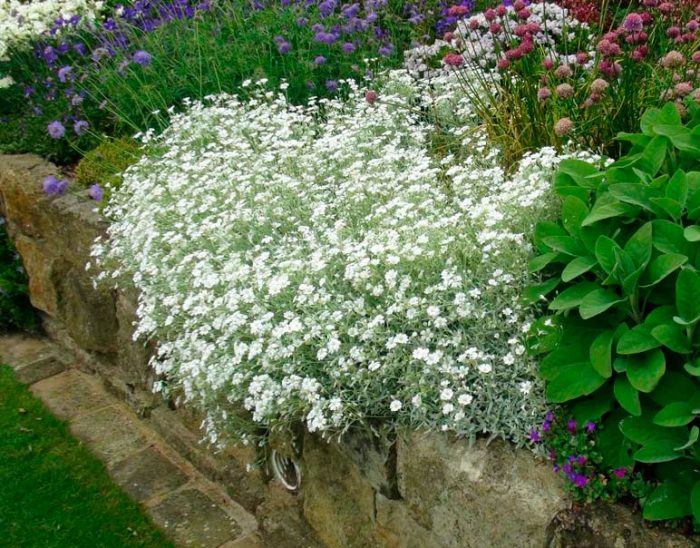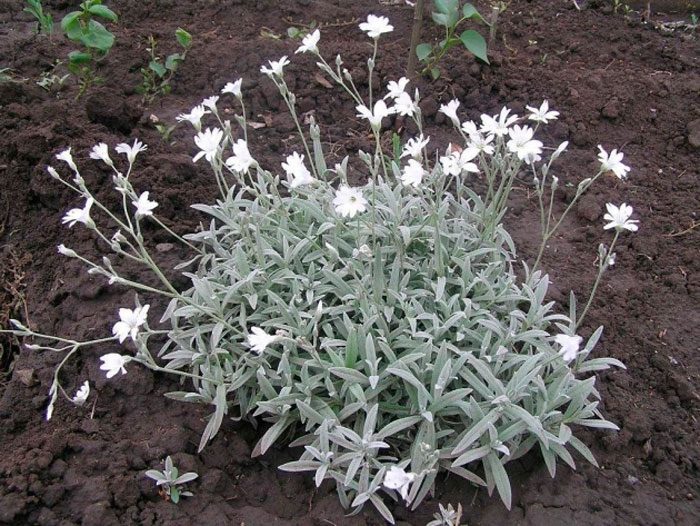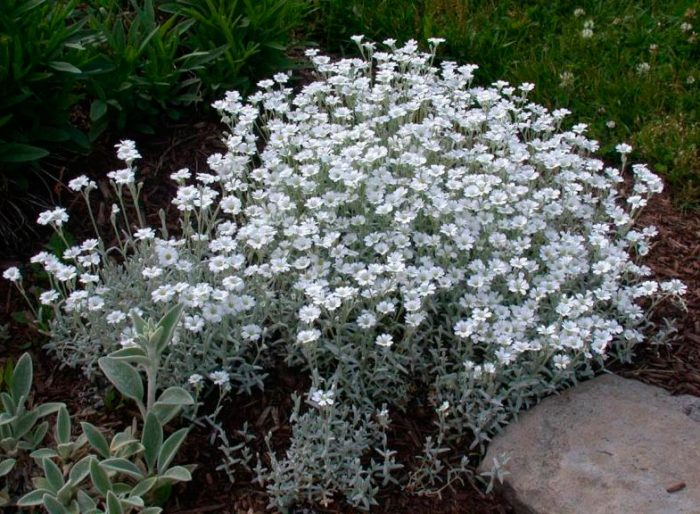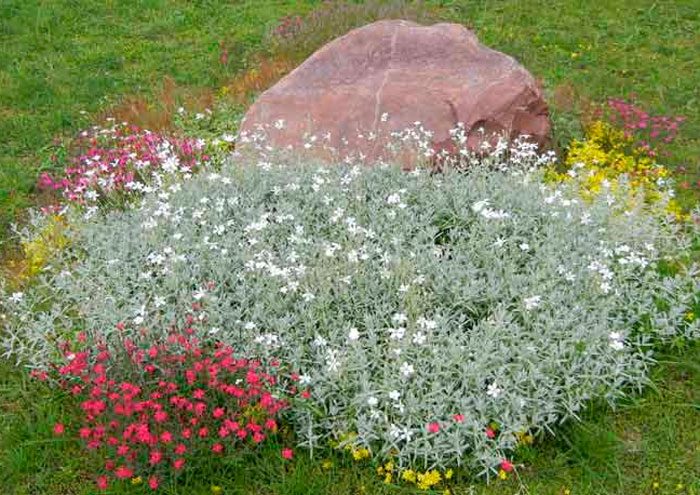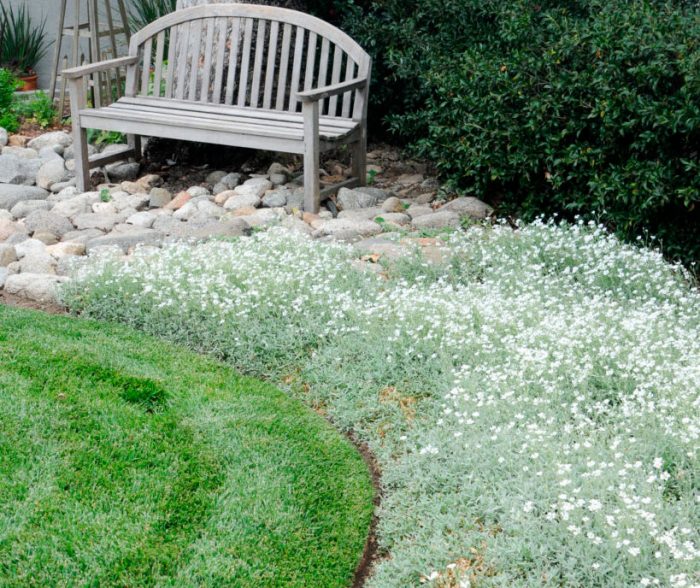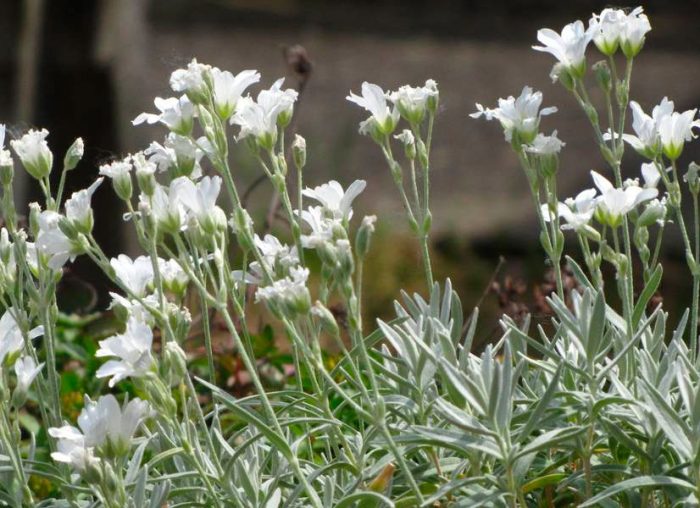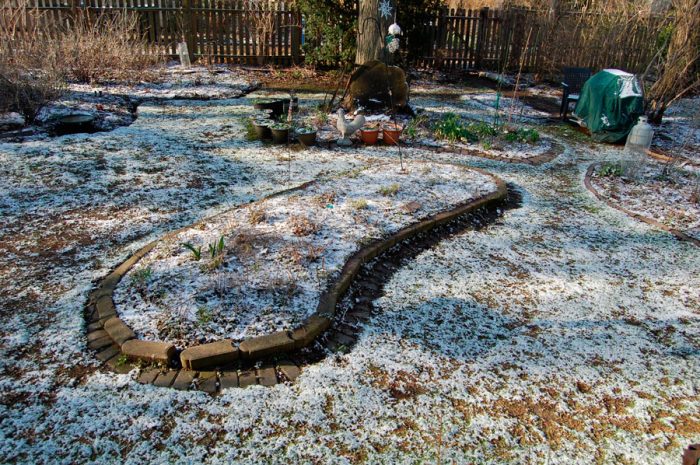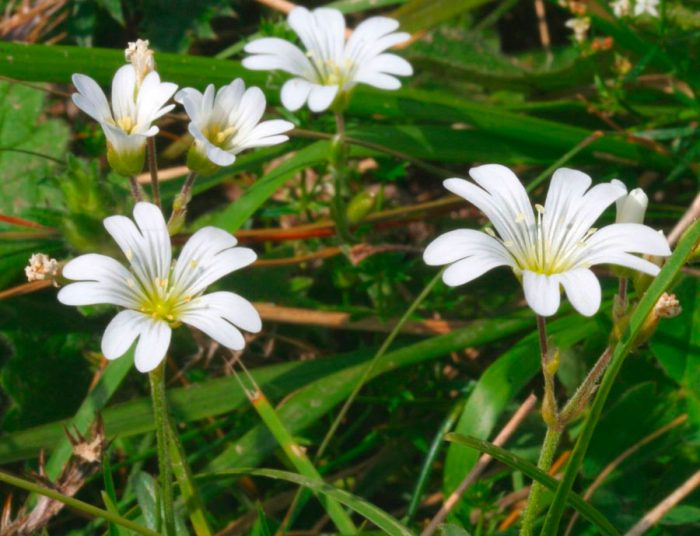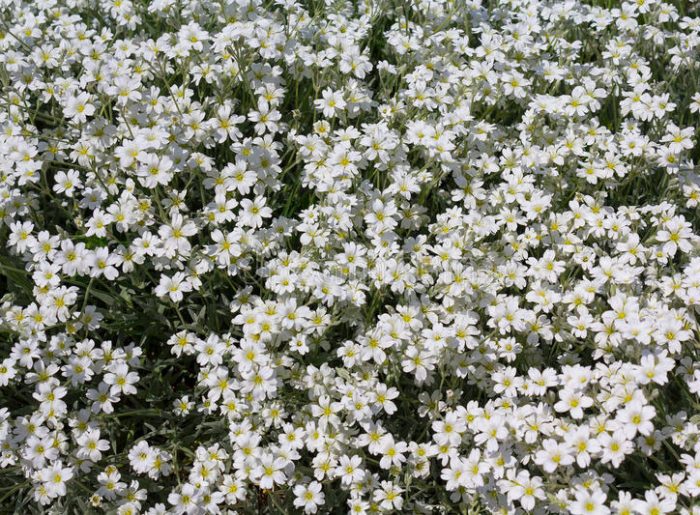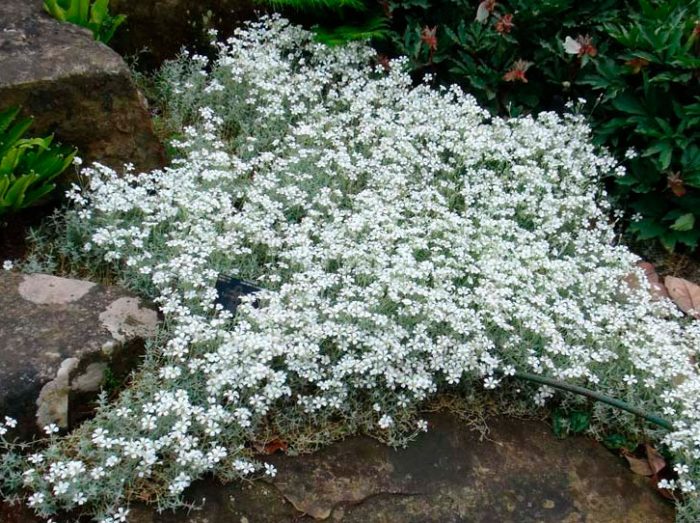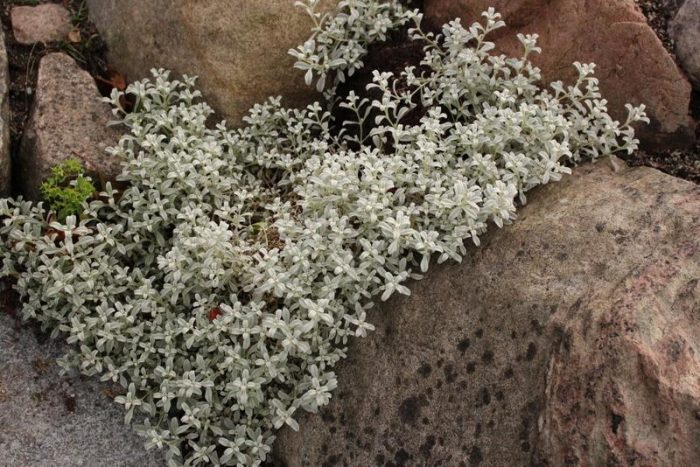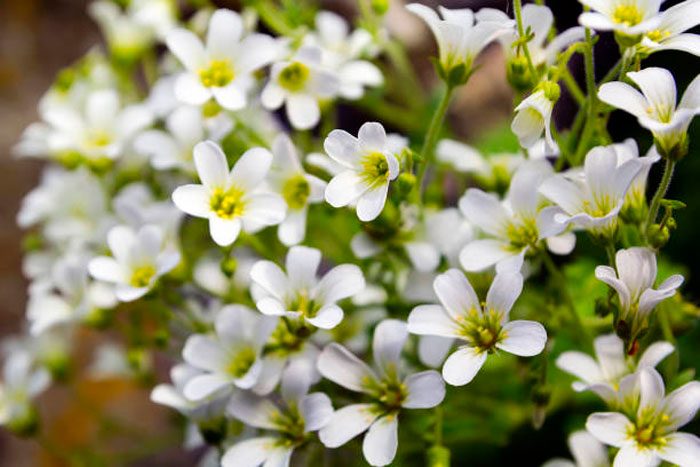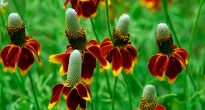The herbaceous annual or perennial plant of the laskolka (Cerastium) is a member of the Clove family. In nature, such a plant is found in regions with a temperate climate in Australia, North and South America, Eurasia and North Africa. This genus unites about 200 species. The scientific name of this kind comes from the Greek word that translates as "horned", it is associated with the shape of the fruit of some species of jaskolok. In this genus, some of the species are very popular with gardeners.
Content
Features of the splinter
The herbaceous plant of the shingle has erect or ascending shoots, their height varies from 0.1 to 0.3 m, as a rule, they have pubescence, but they are sometimes naked. The root system is strong but shallow and can grow in rocky soil. The creeping stems take root very well. Opposite solid small leaf plates, as a rule, have dense pubescence. White flowers, reaching 20 mm in diameter, have two-cut petals. The fruit is a cylindrical oblong box with brown seeds inside.
Planting chicks in open ground
What time to plant
Grown chickweed from seeds through seedlings or in a seedless way. Sowing seeds can be done immediately in open soil, they do it in April or before winter. The emerging seedlings must be thinned out, while a distance of 50 mm must be maintained between the plants.
However, the most popular among gardeners is the propagation method through seedlings. Sowing seeds for seedlings is carried out in the last days of February or in March. The seeds of such a plant are distinguished by good germination and after only 7 days the first seedlings should appear. It is very simple to grow chickweed seedlings, you need to water it in a timely manner and loosen the surface of the substrate. The picking of seedlings is carried out after the formation of the second or third true leaf plate begins; for this, individual cups are used. Planting seedlings in open soil is carried out in July.
Landing rules
This culture is one of the most light-loving ground cover plants. In this regard, for planting it, you can choose sunny open areas that are illuminated throughout the day. A place suitable for planting such a plant must be protected from strong gusts of wind and drafts.
Such a plant is distinguished by its aggressiveness. One small bush is capable of capturing an area reaching about 0.75 m in diameter. In this regard, after planting a jascola, the site must be limited around the perimeter. This culture is undemanding to the composition of the soil. It is possible to grow such a flower on rocky ground, but a small amount of peat should be added to it. But the best for growing such a plant is a loose, airy and light soil of a slightly alkaline or neutral reaction, which contains a large amount of sand. Before planting seedlings in open soil, within 15–20 days, the site should be digged to the depth of a shovel bayonet, and 6 kilograms of humus should be added for each 1 square meter. If the soil is clay or loamy, then sand must be added to it. Before proceeding with the planting of the chick, the soil on the site must be thoroughly loosened. Before planting, the seedlings must be hardened. Plants should be planted in not very deep holes, the distance between which should be about 0.3 m. The holes should be filled up, and the planted plants should be well watered. The first flowering of a chickweed grown from seeds will come only in the second year of growth.
Caring for a chick in the garden
Yaskolka is distinguished by its unpretentiousness, so it is quite simple to grow it in your garden plot. Best of all, such a flower grows on poor soil, while the site should be sunny and open. In springtime, be sure to clear the area where such a crop grows from plant debris, old branches and loose leaves. Then this plant needs to ensure timely weeding, watering, pruning. You should also cut off wilted flowers in time, and also loosen the surface of the soil between the bushes, but this may not be done.
How to water and feed
This crop is resistant to drought, but it still needs systematic watering, it should be done once every 7 days. If it rains regularly in the summer, then you do not need to water the shrub. But during a prolonged drought, it is imperative to water such a flower.
Experts do not have a consensus on whether such a culture is necessary for feeding. Some of them are sure that the plant grows well without them, and in the opinion of the rest, the shrub will respond well to several dressings made during the summer. Gardeners who decide to feed such a flower should use fertilizer for garden ornamental plants for this purpose. He also reacts normally to feeding with organic fertilizers (solution of mullein or bird droppings), they are recommended to be introduced into the soil alternately with minerals. During the growing season, you need to feed the shingle only 2 or 3 times.
How to trim
This herb is prone to strong growth, in this regard, it needs mandatory pruning. In spring, sanitary pruning is carried out, during which it is necessary to cut out all dried, injured and damaged by frost or disease stems. Also, in the spring or during the flowering period, formative pruning is carried out, as a result of which the gardener will have to direct the stems in the desired direction and remove all excess shoots. When the bushes fade, it is imperative to cut off all the shoots with peduncles. If pruned correctly, the lamb will begin to bloom again in the last weeks of the summer. But it should be borne in mind that the re-flowering is less lush.
How to transplant
Such a crop in the same place in the garden can be grown for many years.However, sooner or later, the bushes will grow strongly, and they will need to be transplanted and rejuvenated. During transplantation, the chicks are propagated by dividing the bush. This is best done in early spring. To begin with, the bushes must be subjected to strong pruning, then they are removed from the soil and divided into parts. Each of the sections should be cleaned of rotting and dried roots. The planting of the cut in open soil is carried out in the same way as the initial planting of the dweller. Experienced gardeners recommend transplanting bushes at least 1 time in 5 years.
Wintering
Yaskolka perennial is characterized by moderate frost resistance, while in regions with warm winters, it is not necessary to cover the bushes for wintering. But in areas with little snow and frosty winters, the plant needs shelter, which can be used as spunbond or lutrasil. Fallen leaves or spruce branches are not advised to be used for shelter, since the bushes under them often begin to rot.
Diseases and pests
Yaskolka is very resistant to pests and diseases. As a rule, harmful insects or diseases affect only those bushes that have been weakened by improper care or non-observance of the rules of agricultural technology. If you water the plant very abundantly and often, then rot appears on its root system. In order to prevent, the bushes need to be watered correctly, systematically inspect them, pick off fading flowers and stems in time, and you also need to pull out all the weeds immediately after they appear.
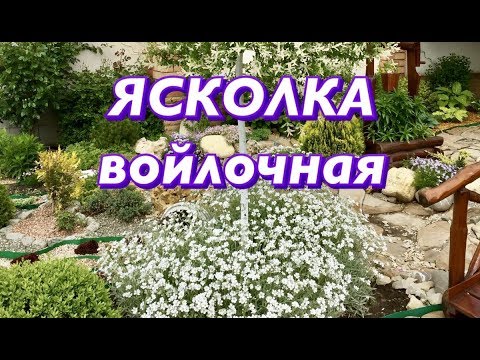

Watch this video on YouTube
Types and varieties of yaskolka with photos and names
Gardeners cultivate not a very large number of jascolka species. However, among them you can still find the kind that will definitely be able to decorate your garden plot.
Alpine lizard (Cerastium alpinum)
Under natural conditions, this species is found in the Carpathians, as well as in the Altai mountains, Western Europe and North America. Such a herbaceous perennial plant reaches a height of about 15 centimeters. The shoots of the bushes are creeping. On the surface of the green-silvery leaf plates there is pubescence, and their shape is ovoid. Inflorescences consist of white flowers, up to 20 mm in diameter.
Bieberstein chisel (Cerastium biebersteinii)
The birthplace of such a perennial plant is the Crimea, the bush is covered with pubescence, due to which it has a bluish color. The stems are creeping, and the peduncles are 15 to 20 centimeters high. Sedentary leaf plates can be oblong-linear or linear. At the tops of the peduncles, semi-umbellate inflorescences are formed, consisting of white flowers, reaching 15 mm in diameter. This species has been cultivated since 1820. The most popular variety is the Silver Carpet: a bush with creeping shoots forms a dense pillow, it is covered with dense pubescence, flower stalks are about 20 centimeters high. The color of the flowers is white. Sessile leaf plates are relatively small.
Felt chickweed (Cerastium tomentosum)
The homeland of such a plant is the southern part of Italy. It forms pillows, the height of which is about 0.3 m, and in diameter they reach 0.6 m. On the surface of the creeping stems there is a gray felt pile. Small leaf plates are colored light gray. White flowers reach 10 mm in diameter. This plant, in comparison with other species, does not grow very much, and therefore it is often grown in rock gardens. It has been cultivated since 1620.The following varieties are popular among gardeners:
- columnae - this variety is frost-resistant, it reaches a height of 15 centimeters;
- Crystal waterfall - the height of the bush is about 20 centimeters, white flowers on short, thin shoots.
White chickweed (Cerastium candidissimum), or snow-white chickweed
This species is Greek endemic.Bushes are covered with dense tomentose pubescence, they form dense cushions. Erect shoots. The shape of the upper leaf plates is linear-lanceolate, and the lower ones are oblong-spatulate. The flowers are double dissected and are large in size.
Ural shingle (Cerastium uralense)
This species is endangered and therefore is listed in the Red Book. The sod of the bush is loose. The length of the ascending shoots is 8–25 centimeters. And the length of lanceolate leaf plates is about 40 mm, and their width is up to 80 mm. The color of the flowers is white, their petals are cut by one quarter.
Even gardeners cultivate such species as: field shrub, large-flowered and purple.

